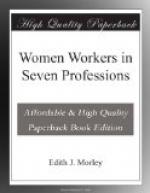Not only is her salary low, but a mistress in a rural school often has to live in a state of semi-isolation from social and intellectual activities. It should excite no surprise, therefore, that mistresses are reluctant to apply for such posts. This difficulty of shortage of supply is having a sinister and subtle effect on the economic interests of married women teachers, for, owing to the difficulty in obtaining assistant teachers in rural districts, it frequently happens that where the head teacher is a master, his wife, who may be a fully qualified certificated teacher, has to act as his assistant and receive the pay of a supplementary teacher.
During her years of service, each mistress in an elementary school is required to contribute L2, 8s. per annum to the Government Superannuation Fund. These contributions purchase a small annuity to which the Government add a pension at the rate of 10s. for each year of service. When she becomes qualified for a pension, the mistress must surrender her certificate and cease to practise as a teacher, so that, if we assume she has begun work at the age of twenty and has continued teaching to the age of sixty-five, she will, after forty-five years of recorded service, receive a pension of L22, 10s. per annum, plus the annuity which her contributions will have purchased. It should, however, be mentioned that London and a few other towns have established complementary schemes whereby teachers, though contributing more, obtain pensions more commensurate with their salaries. Under the Government scheme, the superannuation allowance cannot become payable until the teacher has attained the age of sixty-five years, and, even then, it can be obtained only by a teacher whose years of recorded service are not less than half the number of years which have elapsed since she became certificated; thus, if the mistress, being certificated at the age of twenty, marries and, by the regulations of the local authority, is forced to resign, she forfeits all claim to the Government contribution, unless she has completed twenty-two years of recorded service: nor are her contributions returned to her.
Teachers in elementary schools are well organised for the purpose of self-protection. The National Union of Teachers is a powerful body, having a membership of 78,000 men and women teachers. It is directly represented in Parliament, both on the Liberal and Labour sides, and owes its influence largely to the voting power of its members.[8]




